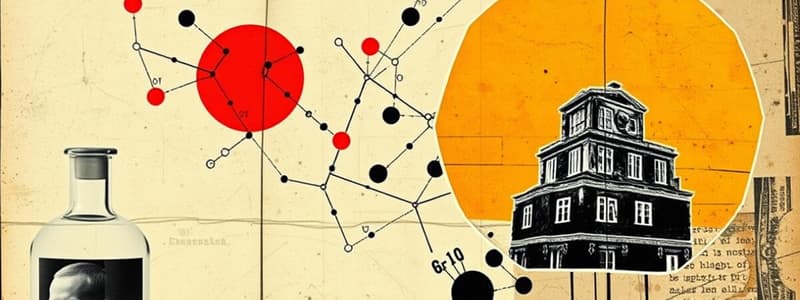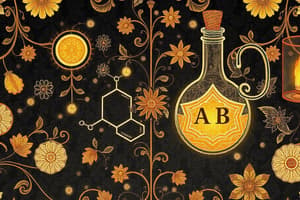Podcast
Questions and Answers
How do ions form?
How do ions form?
Ions form when an atom loses a valence electron and becomes a positive ion, or when it gains an electron and becomes a negative ion.
How are the formulas and names of ionic compounds written?
How are the formulas and names of ionic compounds written?
For formulas, write the symbol of the positive ion followed by the negative ion and add subscripts to balance charges. For names, the positive ion's name comes first, followed by the negative ion's name.
What are the properties of ionic compounds?
What are the properties of ionic compounds?
Ionic compounds form hard brittle crystals with high melting points and conduct electric current when dissolved in water or melted.
Why do the noble gases not react with other elements?
Why do the noble gases not react with other elements?
What are valence electrons?
What are valence electrons?
What is an electron dot diagram?
What is an electron dot diagram?
What is a chemical bond?
What is a chemical bond?
Why do atoms bond?
Why do atoms bond?
What determines an element's chemistry?
What determines an element's chemistry?
How are elements in a group related regarding their valence electrons?
How are elements in a group related regarding their valence electrons?
How do metals chemically react?
How do metals chemically react?
What determines the reactivity of metals?
What determines the reactivity of metals?
How does the reactivity of metals change as you move from left to right on the periodic table?
How does the reactivity of metals change as you move from left to right on the periodic table?
How can nonmetals become stable?
How can nonmetals become stable?
What do nonmetals usually combine with, and how?
What do nonmetals usually combine with, and how?
Can nonmetals combine with anything other than metals, and if so, how?
Can nonmetals combine with anything other than metals, and if so, how?
What is special about the halogens?
What is special about the halogens?
How do metalloids bond?
How do metalloids bond?
Why is hydrogen all alone on the periodic table?
Why is hydrogen all alone on the periodic table?
What does 8 valence electrons indicate?
What does 8 valence electrons indicate?
What is an ion?
What is an ion?
What is a polyatomic ion?
What is a polyatomic ion?
What is an ionic bond?
What is an ionic bond?
What is an ionic compound?
What is an ionic compound?
What is a chemical formula?
What is a chemical formula?
What is a subscript in a chemical formula?
What is a subscript in a chemical formula?
What is a crystal?
What is a crystal?
What is a covalent bond?
What is a covalent bond?
How are atoms held together in a covalent bond?
How are atoms held together in a covalent bond?
What is a molecule?
What is a molecule?
What is a single bond?
What is a single bond?
What is a double bond?
What is a double bond?
What is a triple bond?
What is a triple bond?
What is a molecular compound?
What is a molecular compound?
What is a nonpolar bond?
What is a nonpolar bond?
What is a polar bond?
What is a polar bond?
What are the properties of molecular compounds?
What are the properties of molecular compounds?
How do bonded atoms become partially charged?
How do bonded atoms become partially charged?
What is a metallic bond?
What is a metallic bond?
What is an alloy?
What is an alloy?
What is the structure of a metal crystal?
What is the structure of a metal crystal?
What are the properties of metals?
What are the properties of metals?
What does an electron dot diagram show?
What does an electron dot diagram show?
What is the difference between polar bonding and nonpolar bonding?
What is the difference between polar bonding and nonpolar bonding?
The number of valence electrons in each atom helps determine the ____ of that element.
The number of valence electrons in each atom helps determine the ____ of that element.
When a neutral atom loses a valence electron, it loses a negative charge. It becomes a ____ ion. When a neutral atom gains an electron, it gains a negative charge and becomes a ____ ion.
When a neutral atom loses a valence electron, it loses a negative charge. It becomes a ____ ion. When a neutral atom gains an electron, it gains a negative charge and becomes a ____ ion.
Why are metallic bonds good conductors of heat and electricity?
Why are metallic bonds good conductors of heat and electricity?
Give an example of a polar bond and a nonpolar bond, and explain why they are classified as such.
Give an example of a polar bond and a nonpolar bond, and explain why they are classified as such.
Flashcards are hidden until you start studying
Study Notes
Ion Formation
- Ions form when an atom loses a valence electron, resulting in a positive charge, or gains an electron, giving it a negative charge.
Ionic Compounds
- Ionic compound formulas consist of the positive ion followed by the negative ion, with subscripts to balance charges.
- Naming conventions for ionic compounds place the name of the positive ion first, followed by the negative ion.
Properties of Ionic Compounds
- Characterized by hard, brittle crystals with high melting points.
- Conduct electricity when dissolved in water or melted.
Noble Gases
- Noble gases are nonreactive due to having a complete valence shell of electrons.
Valence Electrons
- Valence electrons are the highest energy electrons that determine an element's chemical properties.
Electron Dot Diagram
- Depicts a chemical symbol surrounded by dots that represent the atom's valence electrons.
Chemical Bonds
- Chemical bonds are the attractive forces that hold atoms together, resulting from electron rearrangement.
Atom Bonding
- Atoms bond to achieve stability by filling their valence shells with electrons.
Element Chemistry
- An element's chemistry is primarily determined by its number of valence electrons.
Group Properties
- Elements within a group share the same number of valence electrons, leading to similar properties.
Behavior of Metals
- Metals typically react by losing their valence electrons.
- Metal reactivity decreases from left to right across the periodic table based on the ease of losing valence electrons.
Nonmetals and Stability
- Nonmetals achieve stability by gaining or sharing electrons to complete their valence shell.
Halogens
- Halogens (Group 17) are highly reactive, needing only one more electron to fill their valence shell.
Metalloids
- Metalloids can both lose and share electrons during bonding with other elements.
Hydrogen
- Hydrogen is unique on the periodic table as a nonmetal with distinct properties compared to alkali metals, often forming bonds by sharing its electron.
Valence Electron Characteristics
- Eight valence electrons confer stability, rendering an element nonreactive.
Ions
- Ions are atoms or groups of atoms with an electric charge, which can be positive or negative.
- Polyatomic ions consist of multiple atoms and can have overall positive or negative charges.
Ionic Bonds and Compounds
- Ionic bonds are formed through the attraction between oppositely charged ions, resulting in ionic compounds that maintain an equal ratio of positive and negative ions.
Chemical Formulas
- Chemical formulas utilize symbols to indicate the ratios of elements in compounds, with subscripts showing the quantity of each element.
Crystal Structure
- Ionic compounds arrange in an orderly, three-dimensional crystal structure.
Covalent Bonds
- Covalent bonds form when two atoms share electrons; the bond strength is due to attractions between shared electrons and nuclei.
Molecular Compounds
- Composed of molecules, molecular compounds typically do not conduct electricity like ionic compounds and generally have lower melting and boiling points.
Polar and Nonpolar Bonds
- Polar bonds result from unequal electron sharing; nonpolar bonds result from equal sharing of electrons.
Metallic Bonds
- Metallic bonds arise from the attraction between positively charged metal ions and delocalized electrons, allowing metals to conduct heat and electricity effectively.
Alloys
- Alloys are mixtures containing two or more elements, at least one being a metal.
Metal Properties
- Metals exhibit a shiny luster, high malleability, ductility, and excellent electrical and thermal conductivity.
Covalent Bonding Details
- Single, double, and triple bonds refer to the number of electron pairs shared between atoms.
Conductivity in Metallic Bonds
- Metallic bonds facilitate electrical and thermal conductivity due to the free movement of valence electrons.
Examples
- Nonpolar bond example: H₂ molecule, because of equal electron sharing.
- Polar bond example: Water (H₂O), where oxygen attracts electrons more than hydrogen.
Studying That Suits You
Use AI to generate personalized quizzes and flashcards to suit your learning preferences.




